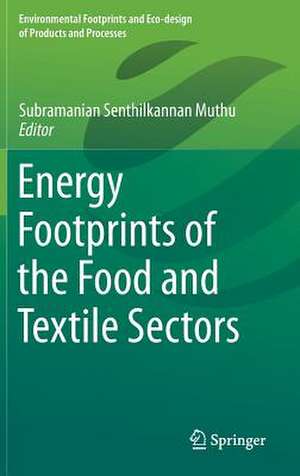Energy Footprints of the Food and Textile Sectors: Environmental Footprints and Eco-design of Products and Processes
Editat de Subramanian Senthilkannan Muthuen Limba Engleză Hardback – 31 ian 2019
Din seria Environmental Footprints and Eco-design of Products and Processes
- 18%
 Preț: 780.06 lei
Preț: 780.06 lei - 18%
 Preț: 1011.77 lei
Preț: 1011.77 lei - 18%
 Preț: 1118.62 lei
Preț: 1118.62 lei - 17%
 Preț: 525.63 lei
Preț: 525.63 lei - 18%
 Preț: 956.09 lei
Preț: 956.09 lei -
 Preț: 359.53 lei
Preț: 359.53 lei - 18%
 Preț: 893.71 lei
Preț: 893.71 lei - 18%
 Preț: 952.09 lei
Preț: 952.09 lei - 17%
 Preț: 457.12 lei
Preț: 457.12 lei - 18%
 Preț: 891.33 lei
Preț: 891.33 lei - 18%
 Preț: 957.32 lei
Preț: 957.32 lei - 18%
 Preț: 1233.83 lei
Preț: 1233.83 lei - 15%
 Preț: 644.63 lei
Preț: 644.63 lei - 15%
 Preț: 581.47 lei
Preț: 581.47 lei - 15%
 Preț: 699.28 lei
Preț: 699.28 lei - 15%
 Preț: 518.30 lei
Preț: 518.30 lei -
 Preț: 388.13 lei
Preț: 388.13 lei -
 Preț: 383.12 lei
Preț: 383.12 lei -
 Preț: 383.50 lei
Preț: 383.50 lei - 15%
 Preț: 642.03 lei
Preț: 642.03 lei - 15%
 Preț: 639.73 lei
Preț: 639.73 lei - 19%
 Preț: 540.92 lei
Preț: 540.92 lei - 15%
 Preț: 642.18 lei
Preț: 642.18 lei - 18%
 Preț: 1117.99 lei
Preț: 1117.99 lei - 15%
 Preț: 639.08 lei
Preț: 639.08 lei - 15%
 Preț: 637.59 lei
Preț: 637.59 lei - 15%
 Preț: 638.76 lei
Preț: 638.76 lei - 15%
 Preț: 696.82 lei
Preț: 696.82 lei - 18%
 Preț: 726.69 lei
Preț: 726.69 lei - 15%
 Preț: 580.49 lei
Preț: 580.49 lei
Preț: 635.47 lei
Preț vechi: 747.61 lei
-15% Nou
Puncte Express: 953
Preț estimativ în valută:
121.61€ • 125.46$ • 102.93£
121.61€ • 125.46$ • 102.93£
Carte tipărită la comandă
Livrare economică 04-18 martie
Preluare comenzi: 021 569.72.76
Specificații
ISBN-13: 9789811329555
ISBN-10: 9811329559
Pagini: 98
Ilustrații: VII, 61 p. 15 illus., 9 illus. in color.
Dimensiuni: 155 x 235 mm
Greutate: 0.28 kg
Ediția:1st ed. 2019
Editura: Springer Nature Singapore
Colecția Springer
Seria Environmental Footprints and Eco-design of Products and Processes
Locul publicării:Singapore, Singapore
ISBN-10: 9811329559
Pagini: 98
Ilustrații: VII, 61 p. 15 illus., 9 illus. in color.
Dimensiuni: 155 x 235 mm
Greutate: 0.28 kg
Ediția:1st ed. 2019
Editura: Springer Nature Singapore
Colecția Springer
Seria Environmental Footprints and Eco-design of Products and Processes
Locul publicării:Singapore, Singapore
Cuprins
Energy Footprints of Food Products.- Energy and Carbon Footprint of Food Industry.- Energy Footprints of Textile Products.
Notă biografică
Dr Subramanian Senthilkannan Muthu holds a PhD in Textiles Sustainability and has written around 60 books and 80 research publications. He is well known for his contributions in the field and has extensive academic and industrial experience. He is the Editor-in-Chief of the Textiles & Clothing Sustainability Journal.
Textul de pe ultima copertă
This book addresses energy footprints in the food and textile sectors. Each footprint case study presents essential background information and discusses the scientific consensus, methodological framework, assessment checklist, calculation tools and techniques, applications, challenges and limitations. More importantly, the book explores the application of each indicator/framework in various industrial sectors and the associated challenges, as well as outlooks for the future – essential considerations, given that energy consumption and conservation are the primary elements in any industry’s sustainability strategy.
Caracteristici
Addresses energy footprints in the textile and food sectors Discusses the limitations and challenges in calculating footprints in these sectors Highlights carbon footprints in the food sector on the basis of a representative case study
